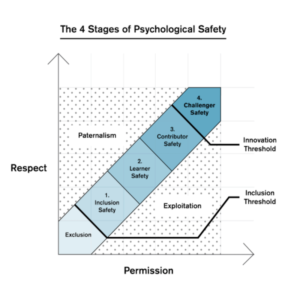As is true of so many groupings of individuals, the workplace is often a microcosm of society at large. This can be a good thing when mutual respect is emphasized. Or, it can be a very bad thing when bullying, harassment, or humiliation are tolerated as part of the culture. Promoting psychological safety in the workplace reverses such trends, unleashing the full potential of individuals and organizations to make them the best they can be.
First, we must define our terms: “Psychological safety is a shared belief held by members of a team that the team will not embarrass, reject, or punish you for speaking up. When you have psychological safety in the workplace, people feel comfortable being themselves. They bring their full selves to work and feel ok laying all of themselves on the line.” (ccl.org)
Needless to say, “laying all of themselves on the line” can be emotionally dangerous if reciprocal respect and support are not part of the culture fostered by leaders as well as team members.
While diversity for its own sake is often seen as a value in many organizations, and among the public at large, it is diverse experiences and thinking that offer real value to an organization.
“Groups made up of people with different life experiences bring together many valuable perspectives. And diverse groups are better able to recognize problems and offer up creative solutions than groups of people with similar life experiences.” (ccl.org)
In other words, groupthink and a “we’ve always done it this way” mentality have little value when problems arise and changes are needed. Rather, a variety of viewpoints are often the best (only?) way for organizations to move forward.
Defining the 4 Stages of Psychological Safety
As defined in the seminal work on the subject, The 4 Stages of Psychological Safety: Defining the Path to Inclusion and Innovation by Dr. Timothy Clark, there are four stages team members must pass through to feel psychologically safe at work.
- Stage 1: Inclusion Safety – Inclusion safety satisfies the basic human need to connect and belong. In this stage, you feel safe to be yourself and are accepted for who you are, including your unique attributes and defining characteristics. “When we create inclusion safety for others, regardless of our differences, we acknowledge our common humanity and reject false theories of superiority and arrogant strains of elitism.”
- Stage 2: Learner Safety – Learner safety satisfies the need to learn and grow. In this stage, you feel safe to exchange in the learning process, by asking questions, giving and receiving feedback, experimenting, and making mistakes. “When we create learner safety for others, we give encouragement to learn in exchange for a willingness to learn.”
- Stage 3: Contributor Safety – Contributor safety satisfies the need to make a difference. You feel safe to use your skills and abilities to make a meaningful contribution. “When we create contributor safety for others, we empower them with autonomy, guidance, and encouragement in exchange for effort and results.”
- Stage 4: Challenger Safety – Challenger safety satisfies the need to make things better. You feel safe to speak up and challenge the status quo when you think there’s an opportunity to change or improve. “When we create challenger safety, we give air cover in exchange for candor.”
If a leader’s primary task is to encourage inclusion and innovation, then fostering a psychologically safe environment is the single most important path to doing so.
Accept the Challenge of Providing Psychological Safety
By their very nature, heart-centered leaders are very good at providing psychological safety in the workplace – once they master assertiveness, handling difficult conversations, and giving challenging feedback. Such an environment is of utmost importance during turbulent times such as now, and often, heart-centered leaders do not think of it as a job while doing it. It’s simply a part of who they are and is integral to their leadership style.
However, this often leads them to the point of burnout because of empathy fatigue and vicarious trauma which they may suffer themselves. (A form of shared PTSD, if you will.) They need to learn emotional agility and balance instead, take care of themselves first, and recognize the emotional work they do by providing empathy to create safe environments.
Challenging? Of course. But for a truly compassionate, heart-centered leader, this is a challenge they are happy to accept.
If you are ready to accept such a challenge in your role as a leader, I believe I am the best coach who can help you master psychological safety in the workplace. Click here to schedule your FREE Discovery Call.
